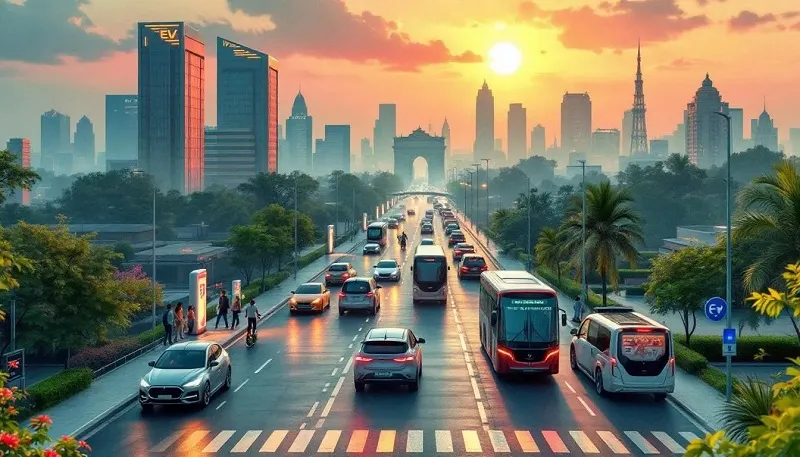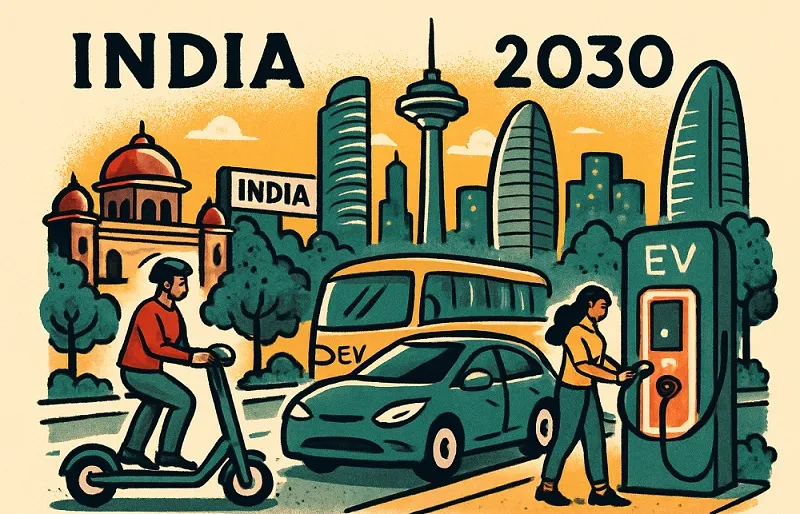India is heading towards a greener future with electric cars revolutionizing the way people commute in cities and towns. The air is polluted, and petrol and diesel prices just keep increasing, so electric cars are a prudent option for most. The government has intentions to get 30 % of cars electric by 2030, providing subsidies and incentives.
From scooters zooming down crowded streets to buses reducing cities’ smokiness, electric cars are here to stay. This blog explains the bright future of electric vehicles in India, covering trends, challenges, and opportunities in simple, clear words.
Government Support Making Electric Vehicles Common:
The Indian government is working hard to get more electric vehicles on the roads with helpful rules and plans. The Faster Adoption and Manufacturing of Electric Vehicles (FAME) scheme discounts buyers, cutting scooter prices by up to 15000 rupees.
The Production Linked Incentive scheme assists manufacturing sites in the process of making batteries enabling 50000 jobs. States like Delhi allow tax exemptions saving 50000 rupees on electric cars. The Electric Mobility Promotion Scheme aims to have 10000 charging stations by 2027.
These overall measures will clarify that the transport industry prefers electric vehicles, but to help more people choose electric over petrol, these will help and be easier to can.
Improved Batteries for Longer Trips:
Batteries are getting better, and electric cars are now more suitable for Indian roads and day-to-day use. Lithium-ion batteries now provide scooters with a 200-kilometer range, twice as much as five years ago. Local Indian companies such as Amara Raja have designed batteries that are 20 % cheaper since 2020.
With 5000 across India, EV battery swapping stations let riders recharge in just 2 minutes. New solid-state batteries, coming by 2028, will charge in 15 minutes and go 300 kilometers. These changes make electric vehicles dependable and affordable, perfect for people in cities or small towns.
Charging Stations Spreading Across India:
Charging ports are being built across India, so electric vehicles can easily travel anywhere. By 2025, India will have 12146 public charging ports with Maharashtra having about 3000. In 2030, the government said it wants 400000 charging ports that can reach the highways and small towns. Petrol stations are becoming charging points with 1000 already changed.
Five hundred solar-powered charging ports save power and cost. Apps also now tell the driver, ChargeZone, shows 8000 charge points are nearby, so the driver doesn’t have to worry about power.
This expanding infrastructure of charge points for EVs is easy to use, especially on long campaigns along highways with small chargers and in remote towns.
Helping People Trust Electric Vehicles:
The popularity of electric vehicles is rising among Indians, who realize they can save money while helping the environment. Advertisements claim electric vehicles can save 50,000 rupees a year on fuel compared to petrol-powered bikes. Ola runs 10,000 electric taxis in Bengaluru and shows they work every day as well.
Social media reaches 50 million people, explaining how electric vehicles cut city pollution by 30 %. Showrooms will let 200000 people test scooters in 2024. These steps make 70 % of city buyers consider electric cars for their next purchase, building trust in cleaner travel.
Electric Scooters Leading the Way:
Indian electric vehicles are dominated by electric scooters at the moment, and for good reasons: scooters help solve traffic congestion in India’s urban areas and also fit the small budgets of many potential buyers. In 2024, scooters accounted for 56% of sales in the electric vehicle category, with 800,000 sold. Several companies like Ola Electric offer scooters that can be purchased for around 80,000 rupees, yielding 30,000 rupees in annual fuel savings.
Scooters are reduced to 10000 rupees cheaper by discounts, boosting sales by 20 %. Five thousand battery swap stations allow riders to refuel quickly. By 2030, 80 % of two-wheeler customers will choose electric, with scooters leading India’s transition to cleaner, cheaper mobility.

Electric Buses Making Cities Cleaner:
Electric buses are elevating public transport in India and helping reduce pollution. They facilitate travel in cities. Delhi has 1300 electric buses that have reduced carbon emissions by 34000 tons annually. The government is supporting 7000 electric buses and will have an additional 2000 in 2024.
The average operational cost of electric buses is roughly 50 % of diesel buses, which saves cities about 10 crore rupees a year. Mumbai is happy with its 500 electric buses, which maintain Wi-Fi coverage while carrying 50000 riders daily.
Private companies like Olectra also manage 1000 bus fleets and take good care of them. Electric buses are keeping cities cleaner and quieter, showcasing to the rest of the world the potential to create better public transportation systems.
Fixing Electric Vehicle Problems:
Electric vehicles have some issues, but India is finding ways to solve them to keep growing. Electric cars are 20 % more expensive than petrol, even with discounts, which is hard for rural buyers.
With only 12146 charging stations, 60 % of highways lack chargers. India depends on 70 % of its batteries being imported, which raises costs by 30 %. Some say electric vehicles depreciate 25 % more when they’re resold. The Indian government plans to roll out 1.32 million chargers and build new battery factories to hopefully bring costs down by 50 % by 2030, to make electric vehicles available to everyone.
Cleaner Environment with Electric Vehicles:
Electric vehicles aren’t just suitable for individual users, they are a huge part of making India’s air a better place and its environment sustainable for all. Electric vehicles, reduces CO2 carbon emissions by 25 % compared to petrol vehicles, approximately 100 million tons saved by 2030. 500 solar chargers at its station use 100kW of clean energy sources, removing 10 % of coal use.
Battery recycling plants handle 10000 tons of waste yearly, keeping things green. Electric vehicles save India 50 billion dollars in oil imports each year. India is building a better future by choosing electricity to reduce pollution, clean urban air, and help combat climate change for a better tomorrow.
Conclusion:
India’s future in electric vehicles looks promising and exciting; scooters and buses will make massive cuts in pollution and savings in their budgets. Discounts, systems to charge batteries faster, better batteries overall, and 12146 different chargers will all help support the industry’s major push into electric vehicles with a target of 30 % by 2030.
Problems like high costs are being fixed with new factories and more chargers. Electric cars create jobs and save 50 billion dollars in oil. Be part of this green change—think about an electric vehicle! What’s one way you can support cleaner roads? Share your ideas!

